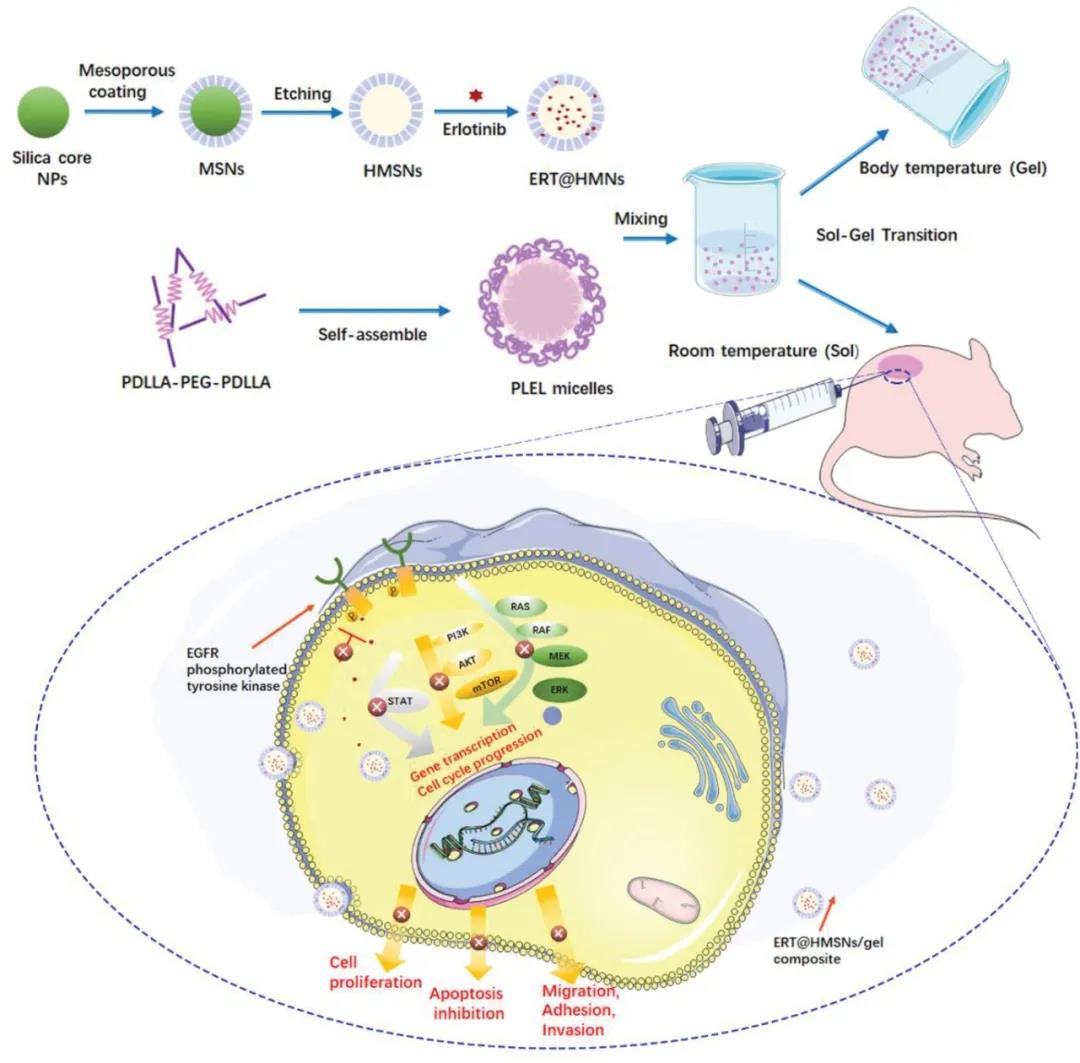
hotline:
17715390137
Tel/Wechat:
18101240246 (Technology)
0512-68565571
Email:mxenes@163.com (Sales Engineer)bkxc.bonnie@gmail.com
Scan the code to follow or search the official account on WeChat:
2D Materials Fronrier After paying attention,
click on the lower right corner to contact us,
Enter enterprise WeChat.
Professional Services Online

 Erlotinib (ERT) is a popular drug for the treatment of lung cancer. Currently, ERT is only available in the form of film-coated tablets on the market. However, due to its strong hydrophobicity, oral ERT has a low drug absorption rate and requires high-dose administration, resulting in a series of side effects such as rash, diarrhea, eye damage and gastrointestinal perforation. The hydrogel-based in-situ drug delivery system can achieve precise drug release from the affected area, reduce the administered dose, and greatly improve the utilization of drugs. However, the hydrogel is an aqueous system, and it is difficult for hydrophobic drugs to mix with it uniformly, which makes it difficult to control the drug loading and release rate.
Erlotinib (ERT) is a popular drug for the treatment of lung cancer. Currently, ERT is only available in the form of film-coated tablets on the market. However, due to its strong hydrophobicity, oral ERT has a low drug absorption rate and requires high-dose administration, resulting in a series of side effects such as rash, diarrhea, eye damage and gastrointestinal perforation. The hydrogel-based in-situ drug delivery system can achieve precise drug release from the affected area, reduce the administered dose, and greatly improve the utilization of drugs. However, the hydrogel is an aqueous system, and it is difficult for hydrophobic drugs to mix with it uniformly, which makes it difficult to control the drug loading and release rate.
In order to solve the above problems, the team of Professor Qian Zhiyong from Sichuan University has developed a temperature-sensitive injectable hydrogel (PLEL) based on polylactide-polyethylene glycol-polylactide (PDLLA-PEG-PDLLA) micelles. Hydrogels). By compounding the hollow mesoporous silica (HMSN) containing erlotinib into the gel system, the controlled release of the drug is realized. Related research papers: Injectable Thermosensitive Hydrogel Containing Erlotinib-Loaded Hollow Mesoporous Silica Nanoparticles as a Localized Drug Delivery System for NSCLC Therapy published in the journal Advanced Science.

Figure 1 Schematic diagram of the drug-loaded injectable thermal gel scheme
1. Hollow mesoporous silica drug-loaded nanocapsules The author synthesized silica nanoparticles based on the improved Stöber method. Then, the mesoporous silica shell is coated on the silica core by the surfactant template sol-gel method. Finally, the particle core is removed by chemical etching to form a hollow structure (Figure 2a).
The loading of the drug is achieved by the solvent evaporation method. Because the prepared nanocapsules have a hollow structure, the final drug loading rate is as high as 45%, which is much higher than ordinary mesoporous silica nanoparticles.

Figure 2 Characterization of hollow mesoporous silica nanoparticles by TEM, SEM, particle size and specific surface area
2. The sustained release of thermally induced gels. In this study, micellar hydrogels based on the central PEG block and the terminal PDLLA block exhibit a reversible temperature-dependent sol-gel-sol transition. As shown in FIG. 3A, as the temperature increases, the resulting hydrogel composite material undergoes the physical state of sol and gel.
The drug-loaded HMSNs particles can be easily incorporated into the hydrogel through simple mixing at an appropriate ratio at room temperature, thereby obtaining a homogeneous and free-flowing HMSNs/PLEL injectable hydrogel negative. Both HMSN gel samples with ERT of 2 mg/mL and 6 mg/mL can maintain no-flow conditions at 37°C, which indicates their gel behavior at body temperature.
Figure 3C shows the cumulative release profile of the drug. The results showed that within the first 72 hours, HMSNs and HMSNs/gel components released 39% and 24% of ERT, which was significantly lower than the free ERT group.

Figure 3 Gelation process and drug release characterization of drug-loaded thermally induced hydrogels
3. In vivo anti-tumor efficiency. Researchers used different ERT formulations to treat nude mouse models of lung cancer. According to the tumor image (Figure 4A) and tumor growth curve (Figure 4B), the results showed that oral ERT, locally injectable ERT@HMSN and ERT@HMSN/gel all showed effective inhibition of A549 tumor development.
Compared with ERT @ HMSNs and oral group, ERT @ HMSNs / gel (50 mg kg -1) can further significantly enhance the anti-tumor effect, and the tumor volume percentage on the 21st day is 30.3% (p <0.01). The optimized delivery system of ERT can significantly improve the therapeutic effect with a relatively low dose. In addition, for the gel group, when the ERT dose in the HMSNs/hydrogel system was increased to 50 mg kg-1 or 100 mg kg-1, the rapid tumor growth was almost completely inhibited, indicating that the ERT in the gel can be Improve the treatment effect in a dose-dependent manner.

Figure 4 A) Photos of subcutaneous tumors in each group: a) blank; b) drug-loaded nanocapsules (50 mg/kg); c, d, e) drug-loaded gel (25, 50, 100 mg/kg); f, g, h) Oral ERT (25, 50, 100 mg/kg per day) B) Tumor growth curve of each group. C) Changes in body weight of mice in each group over time.
In this study, a thermo-sensitive thermo-injectable hydrogel based on triblock polymer was designed as a controlled release platform for hydrophobic anti-tumor drugs. In order to improve the loading of hydrophobic drugs and the dispersibility in the hydrogel, the researchers prepared a hollow mesoporous silica, which increased the drug loading to 45%. This in-situ curing thermally induced hydrogel can control drug release. The results of in vivo experiments show that at lower doses, the drug controlled release system exhibits better tumor growth inhibitory effects than oral drugs.

| Reminder: Beijing Beike New Material Technology Co., Ltd. supplies products only for scientific research, not for humans |
| All rights reserved © 2019 beijing beike new material Technology Co., Ltd 京ICP备16054715-2号 |